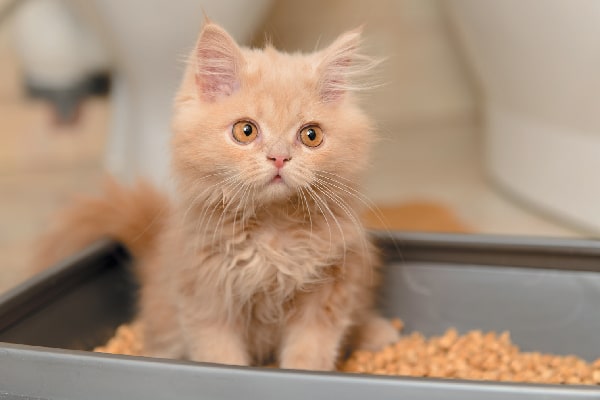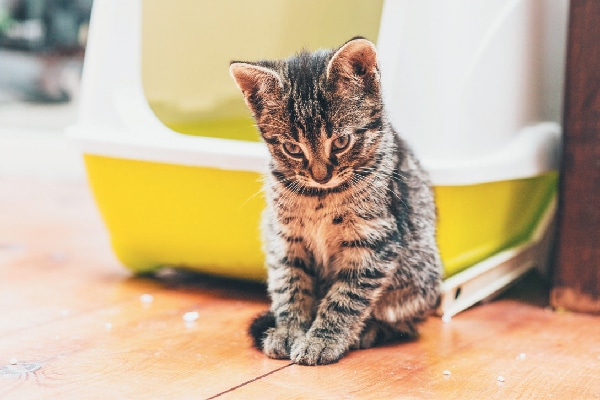6 Common Litter Box Issues — and How to Fix Them
The post 6 Common Litter Box Issues — and How to Fix Them by Rita Reimers appeared first on Catster. Copying over entire articles infringes on copyright laws. You may not be aware of it, but all of these articles were assigned, contracted and paid for, so they aren't considered public domain. However, we appreciate that you like the article and would love it if you continued sharing just the first paragraph of an article, then linking out to the rest of the piece on Catster.com.
Litter boxes can quickly become the bane of a cat parent’s existence when kitty decides to misuse them — or not use them at all. These are some of the most common litter box issues I have come across, both in my practice and with my own cats.
1. Avoidance

Most of the reasons that cats avoid litter boxes actually have easy solutions. Photography © Astakhova | Getty Images.
Litter box avoidance is the most common issue cat owners experience, and it’s the No. 1 reason people surrender their cats to shelters. There are many simple reasons why cats duck the box, and most of them have easy solutions (see below).
2. Guarding or litter box bullying
Alpha cats will often demonstrate their dominance by preventing another cat from either entering or exiting the litter box. Our cat BooBoo is our alpha boy, and more than once I have seen him trap our cat Hope as she’s using the box. Litter box bullying can quickly lead to litter box avoidance, so provide boxes in different areas of your home and make sure each area has an easy escape path for bullied cats.
3. Playing
Most common with kittens, I have seen littermates follow each other into the box and turn potty time into playtime. Sometimes this continues into adulthood, often between siblings. But some adult cats play in the litter, too. One of my client’s cats takes her favorite stuffed animal with her everywhere she goes, including into the litter box. My own Abby will often climb into a freshly cleaned and filled litter box and roll around with glee in the unspoiled litter. I don’t pretend to understand that one!
4. Standing on the rim
My cat Sunny has this habit of standing on the rim of the litter box on his hind legs while leaning against the adjacent wall with his upper body when he uses the litter box. It’s the oddest way I have ever seen a cat use the box. Sometimes it’s successful. Other times he makes a huge mess, either because he misses the box and goes on the floor or because he loses his balance and tips the box over, dumping its entire contents. I’m often left with a mess to clean up, but I can’t help but laugh every time I see Sunny getting himself “into position.”
5. Refusal to bury
Cats are known for being ultraclean and for burying their leavings, but there are times when a cat decides not to bury. Sometimes this happens when a cat doesn’t like the texture and feel of a certain type of litter on his paws; declawed cats will often experience this. Sometimes a cat won’t bury as another way to mark his territory and let everyone know he’s been there. When my BooBoo does this, my Tinkerbelle goes right in there and covers it up for him!
6. Digging and over-burying
Some cats are so intent on burying that they excavate the box for a long time before they are satisfied. My Tinkerbelle buries everything under a pile of litter so high that it actually looks like a pyramid. It takes her a good five minutes to accomplish this. I once took care of a cat named Wilbur who used to pee on the floor, then he would get into the litter box and scoop all the litter out onto the floor to bury what he did. (He actually needed a larger litter box, and the problem was solved!)
If your beloved kitty is exhibiting odd behaviors in the litter box and medical causes have been ruled out, consult with a cat behaviorist to help find a solution to the bad box behavior. Or, depending on your cat’s particular misbehavior, you might want to just sit back and enjoy the show!
Litter Box Avoidance Checklist

Is your kitty avoiding the litter box? Most of the litter box avoidance issues are easily solved. Photography © ysbrandcosijn | Getty Images.
If your new kitten or cat is avoiding the litter box, go through this checklist to solve the problem!
- Medical issues. When your cat isn’t using the litter box, the first thing to do is take him to the veterinarian. Medical issues, like urinary tract disorders, are a common reason for a cat to stop using his box.
- Litter box size. Ideally, your cat’s box should be large enough for him to comfortably turn around inside, without his body hanging over the side. You’ll need a smaller litter box for kittens and then bigger when they outgrow it. You’ll also need one with smaller sides for kittens and senior cats so they can get easily in and out of it.
- Litter box or litter type. Just like us, cats have their own bathroom preferences. Some like a covered litter box and others prefer one that’s not. There are many types of litter boxes out there, so get a variety of them and find out which one your cat prefers. The same goes for litter. Cats with sensitive paws are quite particular about the type of litter they use. With all the choices, get several that work for you and your cat, and offer them in different litter boxes to see which one your cat prefers.
- Box placement. Place the box in a low-traffic area of your home but not somewhere difficult for your cat to reach. If you have a kitten or senior cat, put a box on every level of your home, so he can get to a box quickly and easily.
- Stress. Household changes can quickly cause stress in your cat, and peeing outside of the litter box is commonly the first sign. Adding new people or pets to the household is a common cat stressor.
- Not enough boxes — or not clean enough. If there aren’t enough boxes in a multi-cat household, or if they are not scooped often enough, your cats will find another, cleaner place to go. And I guarantee it won’t be someplace you’ll like. Scoop your litter boxes often, at least twice a day, and offer the same number of boxes as you have cats and one extra.
Tell us: What litter box issues have you experienced? What solutions worked for you?
This article was originally published in 2017.
Thumbnail: Photography © AlbinaTiplyashina | Getty Images.
About the author
Rita Reimers’ Cat Behavior Coaching has helped many cat owners better understand their feline friends. Visit RitaReimers.com to read her cat behavior blog or book a cat behavior coaching session. Rita is also CEO/owner of JustForCatsPetSitting.com. Connect with her on Facebook and on Twitter at @TheCatAnalyst.
Editor’s note: This article appeared in Kittens, a special issue from Catster magazine. Look for Kittens on a newsstand near you!
Read more about cat litter box issues on Catster.com:
- 5 Tips for Controlling Cat Litter Tracking and Scattering
- Litter Training Cats: What You Need to Know
- 7 Ways to Get Your Cat to Like Using the Litter Box
The post 6 Common Litter Box Issues — and How to Fix Them by Rita Reimers appeared first on Catster. Copying over entire articles infringes on copyright laws. You may not be aware of it, but all of these articles were assigned, contracted and paid for, so they aren't considered public domain. However, we appreciate that you like the article and would love it if you continued sharing just the first paragraph of an article, then linking out to the rest of the piece on Catster.com.




Post a Comment